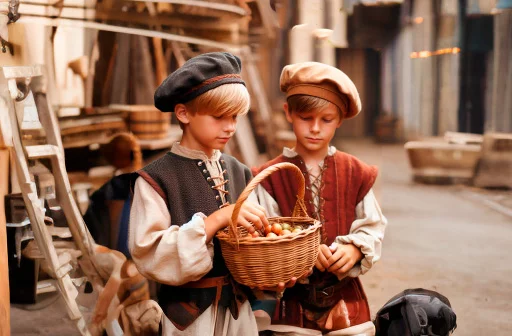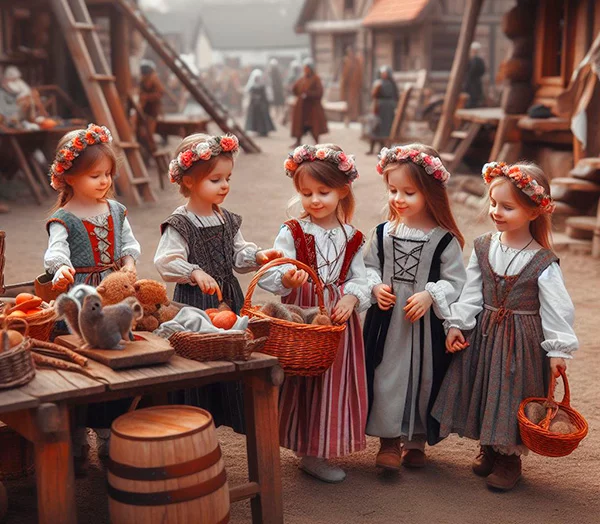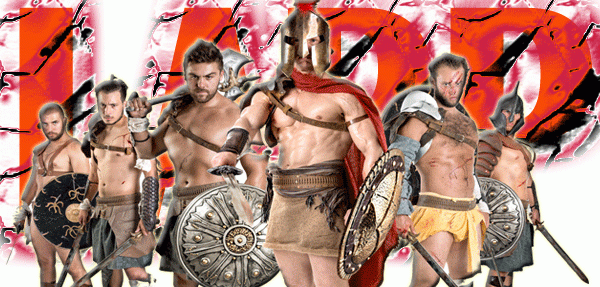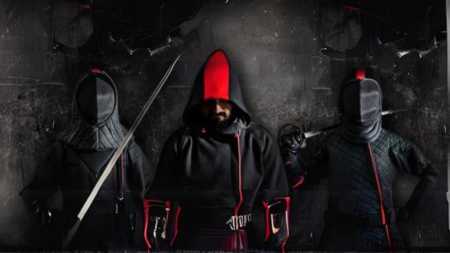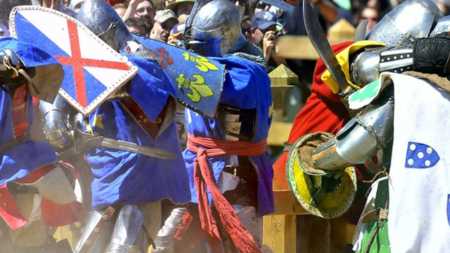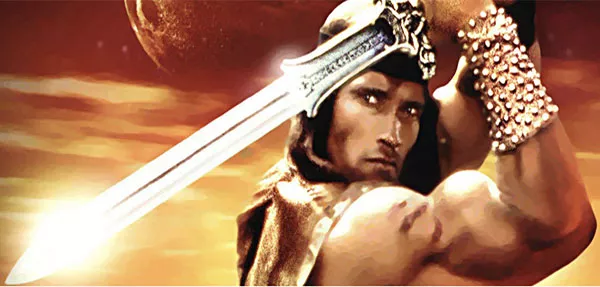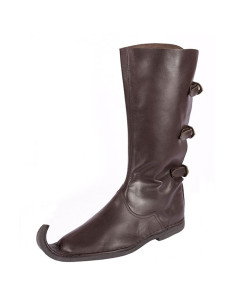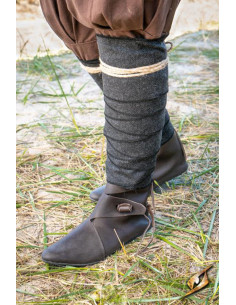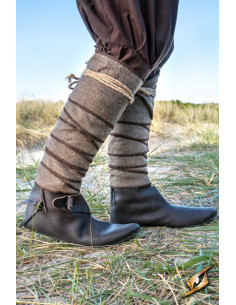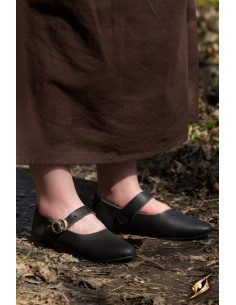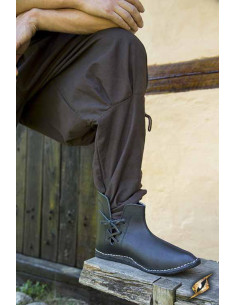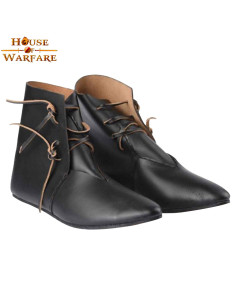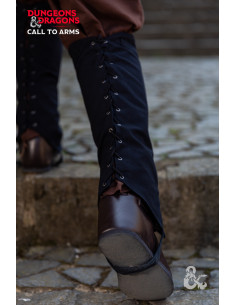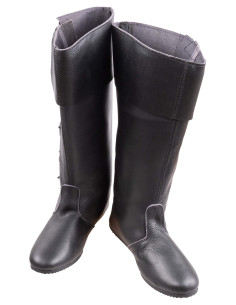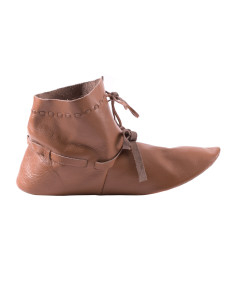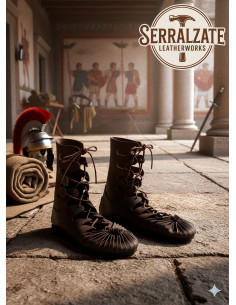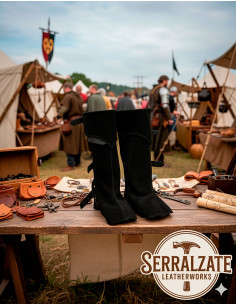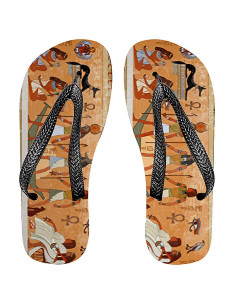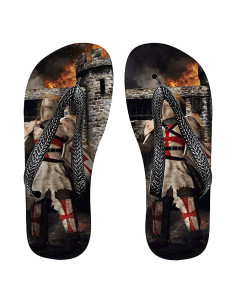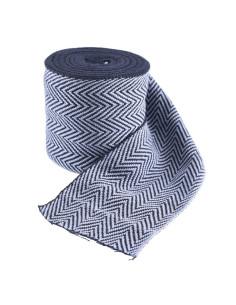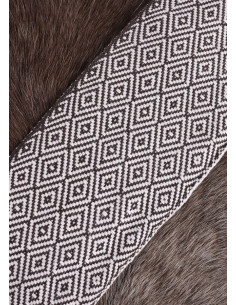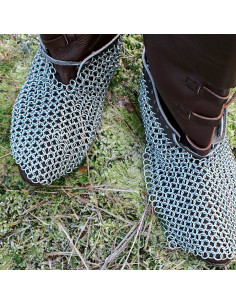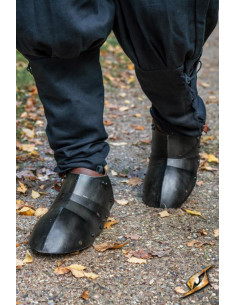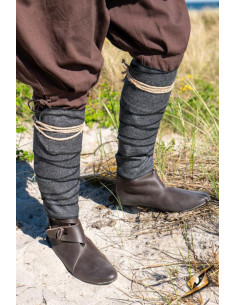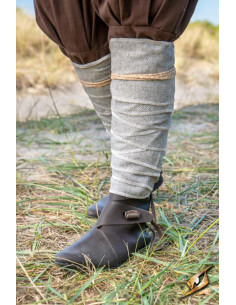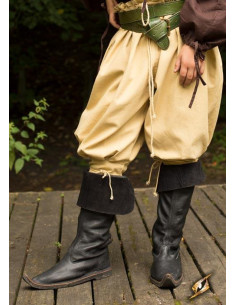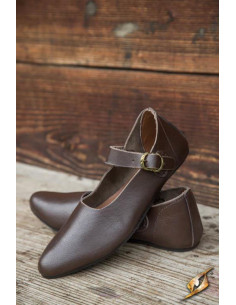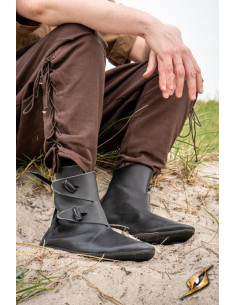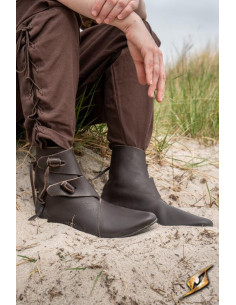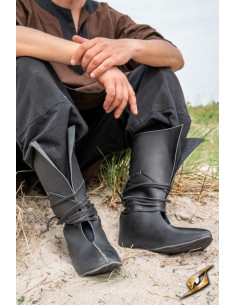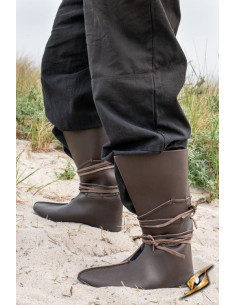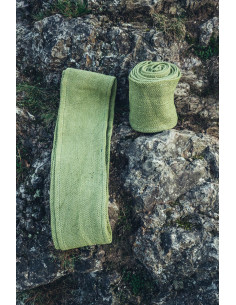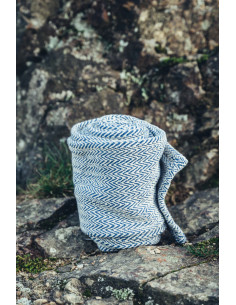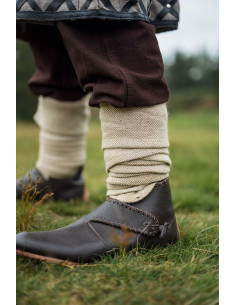Footwear
Black Medieval Escarpes Epic Armoury: Superior Protection for Your Feet
Medieval Footwear - Timeless Elegance and Historical Aesthetics
Medieval Footwear - Timeless Elegance is appreciated in pieces that combine historical design and modern functionality. Models such as the black Rolf Viking and medieval boots or the black Oseberg Viking boots with laces (9th century) recreate the rustic aesthetic of past eras without losing the necessary comfort for today. For women, options like the brown Astrid medieval shoes for women or the Brown Medieval Lady Shoes in leather with lace closure offer more delicate cuts and details designed for feminine silhouettes, maintaining authentic materials and finishes that evoke centuries-old traditions.
In this Footwear category, you will also find pieces inspired by different cultures: from dark brown Roman caliga sandals to late models with buckle closures. Each design offers a different interpretation of history: high boots with buckles, such as the brown high medieval boots with buckle closure, evoke times of travel and combat, while simple Roman sandals recall summer in ancient camps and cities. The blend of aesthetics and historical relevance makes this collection an ideal choice for reenactment, performances, collectors, and lovers of timeless style.
Functional Variety: Boots, Ankle Boots, Sandals, and Flip-Flops
The Footwear in our selection covers multiple uses: boots for cold climates or trails, ankle boots for greater mobility, and sandals for warm climates or Roman reenactments. For example, the black leather medieval ankle boots with lace closure and the brown Galahad medieval ankle boots are excellent for events requiring agility and support. The dark brown knee-high boots with buckles or the brown leather medieval boots model Einhard provide additional protection and stage presence, ideal for costumes and historical portrayals.
For summer environments or Roman settings, the brown leather Roman sandals with lace closure and the light brown leather Caligae Roman sandals offer authenticity and breathability. And for casual moments or summer costumes, the Roman Emperor Summer Flip-Flops near the Colosseum or the Templar Knight Summer Flip-Flops provide a comfortable alternative. Even the Pirates Summer Flip-Flops and Roman Emperor Summer Flip-Flops are designed to combine image and practicality without sacrificing historical coherence.
Materials and Craftsmanship: Leather, Nubuck, Closures, and Details
The quality of the Footwear is defined by the materials and craftsmanship. Classic tanned leather is prominent in models like the black Johann leather medieval boots or the black Tilly medieval boots, offering durability and the possibility of repainting and repair. Nubuck appears in sandals and lighter pieces; for example, the low Roman sandals in nubuck leather provide a soft touch without losing durability. Closures also make a difference: laces in Oseberg Viking boots with laces, buckles in knee-high boots with buckles, and buckle closures typical of the late Middle Ages in Late Medieval Shoes with buckle closure.
Manufacturing details, such as reinforced toe caps, stitched or glued soles according to the recreated era, and interior linings adapted for greater comfort, elevate a costume piece to structured and durable Footwear. Models like the brown Jorik Viking and medieval ankle boots or the black horn Jorvik Viking ankle boots incorporate finishes that balance authenticity and ergonomics. We also offer Black Medieval Sabatons Epic Armoury: Superior Protection for Your Feet, designed for physically demanding activities.
Sizes, Fit, and How to Choose Your Ideal Footwear
Choosing the right medieval Footwear requires more than selecting the model: you must consider size, type of closure, and intended use. The low medieval shoes with lace closure and the black medieval shoes for ladies, Rieke, allow precise adjustment thanks to their laces, while buckle models offer quick adjustment points and aesthetics faithful to certain periods. If you are unsure between sizes, measure the length and width of your foot with the socks and insoles you will wear during the event; comparing these measurements with the product’s size guide reduces returns and improves the experience.
It is also important to consider the last: boots and ankle boots usually have roomier lasts to allow movement and thick socks, while low-cut shoes require a tighter fit. For activities involving frequent movement or simulated combat, prioritize ankle support and non-slip soles. Many of our models, such as the black leather medieval ankle boots with lace closure or the Brown Medieval Lady Shoes in leather with lace closure, have detailed descriptions of last, material, and usage recommendations on each product page.
Care and Preservation of Historical Footwear
To preserve your medieval Footwear, a maintenance routine is essential. Leather needs cleaning with a dry or slightly damp cloth after use, followed by a specific nourishing cream for leather to prevent dryness and cracking. For Roman sandals and summer pieces, such as the dark brown Roman caliga sandals, remove sand and dust, air dry, and apply a light leather treatment if appropriate. Stitched soles should be checked periodically to avoid moisture entering the seams.
Avoid drying in direct sunlight or near intense heat sources: heat breaks fibers and deforms the Footwear. For pieces with metal closures, such as buckles on dark brown knee-high boots with buckles, clean and lightly grease the metal to prevent corrosion. Storing in ventilated boxes or with shoe trees helps maintain shape; if you plan to use the Footwear in reenactments or LARP, inspect reinforcements and seams before each event and repair promptly to extend the lifespan of each piece.
What are the differences between Viking boots and medieval boots within the Footwear category?
Viking boots usually feature wider lasts, less pointed toes, and a focus on fastening with laces or wraps, as seen in models like the black Oseberg Viking boots with laces. Medieval boots can show stylistic variety depending on the period: from high boots with buckles to more formal models with reinforced soles, such as the brown high medieval boots with buckle closure. Our online store offers technical descriptions to help identify the most suitable option according to use and historical accuracy.
How do I know which size to choose in this historical Footwear?Size depends on the manufacturer’s last and the type of sock you will wear. Measure the length of your foot and compare it with the size guide available on each product; consider width and whether you will use insoles. For medieval or Viking ankle boots, an extra size is usually recommended to accommodate thick socks, while low medieval shoes with lace closure tolerate a more precise fit. Check the notes on each product page in our online store for model-specific advice.
Are these shoes suitable for reenactments or LARP with movement and simulated combat?Several models are designed for active use, with durable soles and reinforced toe caps, for example the Black Medieval Sabatons Epic Armoury: Superior Protection for Your Feet. However, suitability depends on the type of activity: for intense fighting, it is advisable to choose pieces with good ankle support and non-slip soles; for parades or static performances, aesthetic finish is prioritized. Always review the specifications of each product in our online store to confirm their suitability for dynamic events.
What specific care does leather Footwear require compared to nubuck or lighter pieces?Natural leather needs cleaning with a soft cloth, hydration with a specific cream, and protection against excessive moisture. Avoid soaking in water; repair small cracks with care products. Nubuck requires gentle brushing and specialized products that do not shine the surface. For sandals and flip-flops, just remove dust and let air dry; apply a light conditioner if recommended by the manufacturer. For all pieces, store Footwear in a ventilated place and use shoe trees to maintain shape.
What Footwear models do we offer designed for women?We have a specific selection for women that combines fit and design: brown Astrid medieval shoes for women, Brown Medieval Lady Shoes in leather with lace closure, and black medieval shoes for ladies, Rieke, are examples that prioritize the female last and aesthetic details. These pieces maintain authentic materials and period-appropriate finishes, and on the product page you will find sizing and usage recommendations. You can consult the women's section in our online store to see availability and measurements.
Which models are most recommended for warm climates within historical Footwear?For warm climates, the brown leather Roman sandals with lace closure, light brown leather Caligae Roman sandals, and dark brown Roman caliga sandals are the most suitable due to their ventilation and lightness. Summer flip-flops, such as the Roman Emperor Summer Flip-Flops near the Colosseum or the Templar Knight Summer Flip-Flops, offer comfort for informal use. If you need additional protection on rough terrain, opt for lightweight ankle boots with good breathability. All these options are detailed in our online store.
Can I restore or repair medieval Footwear if wear appears?Yes, many pieces can be restored: stitched or patched soles by cobblers, seam repairs, and replacement of buckles or laces extend the life of the Footwear. For leather damage, deep cleaning and nourishment treatments can recover flexibility; in severe cases, it is advisable to consult a professional. Product pages indicate which elements are easily repairable and which require specific care. Our online store offers maintenance guides and care product recommendations.
Explore our historical Footwear: find boots, ankle boots, sandals, and sabatons with authentic finishes and modern comfort. Renew your historical wardrobe with pieces faithful to the period, quality materials, and professional fit. Shop now and complete your outfit with timeless elegance.


